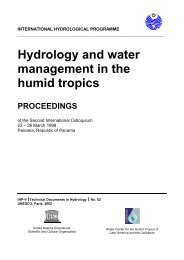FR AB - Science Reference
FR AB - Science Reference
FR AB - Science Reference
Create successful ePaper yourself
Turn your PDF publications into a flip-book with our unique Google optimized e-Paper software.
AMINO ACID COMPOSITION AND<br />
SEQUENCE ANALYSIS<br />
Sechi S, Chait BT.A method to define the carboxy terminal<br />
of proteins. Anal Chem 2000;72:3374–3378.<br />
Proteins are first digested with lysylendopeptidease.<br />
Anydrotrypsin, a catalytically inert derivative of<br />
trypsin in which serine-195 is converted to dehydroalanine,<br />
is used to bind peptides containing a<br />
lysine (or arginine) residue at their C-termini. The<br />
peptide derived from the C-terminus of the intact protein,<br />
lacking a C-terminal lysine or arginine, is not<br />
retained by anhydrotrypsin and is collected for subsequent<br />
analysis. Matrix-assisted laser desorption/ionization<br />
(MALDI) is used to identify the peptide, and<br />
tandem mass spectrometry is used to sequence it.<br />
CARBOHYDRATES AND<br />
GLYCOPROTEINS<br />
Charlwood J, Skehel JM, Camilleri P.Analysis of N-linked<br />
oligosaccharides released from glycoproteins separated<br />
by two-dimensional gel electrophoresis. Anal Biochem<br />
2000;284:49–59.<br />
Protocols are described for analysis of N-linked<br />
carbohydrates on glycoproteins that have been sub-<br />
ARTICLE<br />
WATCH<br />
This column highlights recently published articles that are of interest to the<br />
readership of this publication. We encourage <strong>AB</strong>RF members to forward<br />
information on articles they feel are important and useful to Clive A. Slaughter,<br />
St. Jude Children’s Research Hospital, 332 North Lauderdale Street, Memphis,<br />
TN 38105-2794; Tel: (901) 495-4844; Fax: (901) 495-2945; email: clive.slaughter@<br />
stjude.org; or to any member of the editorial board. Article summaries reflect the<br />
reviewers’ opinions and not necessarily those of the Association.<br />
jected to two-dimensional gel electrophoresis. Glycans<br />
are released from the proteins by digestion with<br />
protein N-deglycosidase F (PNGase F), derivatized<br />
with 3-acetamido-6-aminoacridine, and analyzed by<br />
matrix-assisted laser desorption/ionization (MALDI)–<br />
time-of-flight mass spectrometry. Enzymic release of<br />
the glycan is demonstrated using in-gel digestion of<br />
the excised gel spot, with or without prior tryptic<br />
digestion, and also using glycoproteins electroblotted<br />
to polyvinylidene difluoride membranes.<br />
PHOSPHOLIPIDS<br />
Journal of Biomolecular Techniques<br />
11:181–184 © 2000 <strong>AB</strong>RF<br />
RF <strong>AB</strong><br />
Taguchi R, Hayakawa J,Takeguchi Y, Ishida M.Two-dimensional<br />
analysis of phospholipids by capillary liquid chromatography/electrospray<br />
ionization mass spectrometry.<br />
J Mass Spectrom 2000;35:953–966.<br />
A strategy for analysis of phospholipids extracted<br />
from cultured cells is described. The strategy uses<br />
capillary liquid chromatography combined with tandem<br />
mass spectrometry in a quadrupole mass analyzer.<br />
More than 500 species of phospholipids are<br />
included by the method. Positive molecular ions,<br />
negative molecular ions, positive fragment ions, and<br />
negative fragment ions are monitored, consecutively,<br />
in 11-second cycles. Positive molecular ions indicate<br />
choline-containing phospholipids such as phosphatidylcholine,<br />
sphingomyelin, lysophosphatidylcholine,<br />
and phosphatidylethanolamine. Negative<br />
JOURNAL OF BIOMOLECULAR TECHNIQUES, VOLUME 11, ISSUE 4, DECEMBER 2000 181















